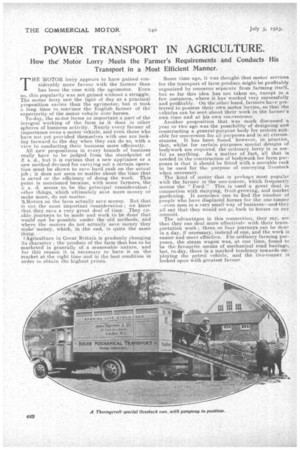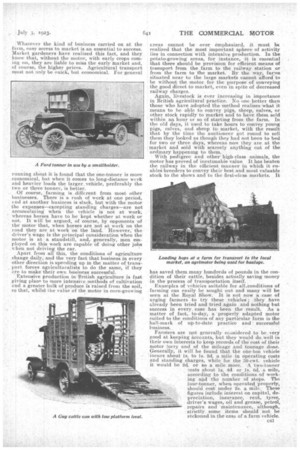POWER TRANSPORT IN AGRICULTURE.
Page 30

Page 31

If you've noticed an error in this article please click here to report it so we can fix it.
How theMotor Lorry Meets the Farmer's Requirements and Conducts His Transport in a Most Efficient Manner.
THE MOTOR lorry appears to have gained considerably more favour with the farmer than has been the case with the agrimotor. Even so, this popularity was not gained without a struggle. . The motor lorry saw the light of day as a practical proposition earlier than the agrimotor, but it took a long time to convince the English farmer of the superiority of the motor vehicle over horses. To-day, the motor forms as important a part of the integral working of the farm as it does in other spheres of business activity.Nearly every farmer of importance owns a motor vehicle; and even those who have not yet provided themselves with one are looking forward to the day when they can do so, with a view to conducting their business more efficiently.
All new prepositions in every branch of 'business really have to be judged from the standpoint of it s. d. but it is curious that a new appliance or a new method devised for -carrying out a certain operation must be shown to save hard cash on the actual job ; it does not seem to matter about the time that is saved or the efficiency of doing the work. This point is mentioned because, with some farmers, the
s. d. seems to be the principal consideration . other things, which ultimately save more money or make more, do not matter.
• a
Motors on the farm actually save mono'. But that is not the most important consideration ; we know . that they, save a very great deal of time. They enable-journeys to he made and work to be done that would not be possible under the old methods, and where the • motors do mit actually save money they Make' meheY, which, in the end, is quite the same thing. ; .
7.AkticaIture in Great Britain is gradually changing its Character ; the: produce of the farm that has to be Marketed is generally of a :§eaaon abl e nature, and for this reason it is necessary to have it on the market at the right time and in the best condition in order to obtain the highest prices.
Some time ago, it was thought that motor services for the transport of farna produce might be profitably organized by concerns separate from farming itself, but so far this idea has not taken on, except in a few instances, where it has worked very successfully and profitably. On the ether hand, farmers have preferred to possess their own motor lorries, so that; the .vehicles can be sent about their work in the farmer's own time and at his own convenience.
Another proposition that was much discussed a year or two ago was the possibility of designing and constructing a general-purpose body for motors suit-able for conversion for all purposes and in all circumstances. ft has been found, however, in practice, that, whilst for certain purposes special designs of bodywork are required, the ordinary lorry is as useful as anything. As a matter of fact, all that is needed in the construction of bodywork for farm purposes is that it should be fitted with a movable rack to be used for the purpose of conveying livestock when necessary.
The kind of motor that is perhaps most popular with the farmer is the one-tonner, which frequently means the " Ford." This is used a great deal in connection with dairying, fruit-growing, and market gardening. It surmises one to find the number of people who have displaced horses for the one-tanner —even men in a very small way of business—and-they all say that they would not gt; back to horses on any account.
The advantages in this connection, they say, are that they can deal more effectivelY with their transportation work; .three or fear journeys can be done in a day, if necessary, instead of one, and the work is easier and mere effective. For ordinary farming purposes, the steam wagon was, at one time, found to be thefavourite means Of mechanical road haulage, but, today, there is a marked tendency towards employing the petrol vehicle, and the two-tonner is looked upon with greatest favour. Whatever the kind of business Carried on at the farm, easy access to market is an essential to success. Market gardeners have realized this fact, and they know that, without the motor, with early crops coming on, they are liable to miss the early market and, of course, the higher prices. Agricultural transport must not only be curia, but. economical. For general running about it is found that the one-tonner is more economical, hut when it. comes to long-distance wcrk and heavier loads the larger vehicle, preferably the two or three tonner, is better.
Of .course, farming is different from most other businesses. There is a rush of -work at one period, i.:nd at another business is slack, but with the motor the expenses—excepting standing charges—are not accumulating When the vehicle is not at work, whereas horses have to be kept whether at work or not. It will be argued, of course, by opponents of the Motor that, when horses are not at work 'On the road they are at work on the land. However, the driver's wage is the principal consideration when the motor is at a standstill, and,generally, men employed on this work are capable of doing other jobs vhen not driving the car.
Apart from all this, the conditions of agriculture change daily, and the very fact that business, in every other direction is speeding up in the matter of transport forces agriculturalists to do the same, if they are to Make -their own business successful.
Extensive production in British agriculture is fast giving place to more intensive methods of cultivation and a greater bulk of produce is raised from the soil, SO that, whilst the value of the motor in corn-growing
areas cannot be over emphasized, it must biE realized that the most important Sphere of activity lies in connection with intensive. production. In the potato-growing areas, for instance, it is essential that there should be provision for efficient means Of transport from the farm to the railway station or from the farm to the market. By the way, farms situated near to the large markets cannot afford to be without the motor for the purpose of conveying the good direct to market, even in spite of decreased railway charges.
Again, livestock is ever increasing in importance in British agricultural practice. No one better than those who have adopted the method realizes what it means to he able to convey pigs, sheep, calves, Or Other stock rapidly to market and to have them sold within an hour or so of starting from the farm. In the old days, it used to take hours to convey young pigs, Calves, arid Sheep to market, with the result that by the time the auctioneer got round to sell -them they looked as though they had not been to bed for two or three days, whereas now they are at the market and sold with scarcely anything out of the ordinary happening to them. With pedigree and other' high-class animals, the motor has proved of inestimable value It has beaten the railway in the efficient mariner iii which it enableS breeders to convey their hest and most valuable stock to the shows and to the first-class markets. It has saved them many hundreds of pounds in the condition of their cattle, besides actually saving money in the process of tranSportation itself.
Examples of vehicles suitable for all oonditions of farming can easily be sought out and many will be seen at the Royal Show. It is not now a case of urging farmers to ti:7 these vehicles; they have already been tried and tried again and nothing but success in every, case has been the result. Aa 4 matter of fact, to-day, a properly adapted motor suited to the conditions of any particular farm is the hall-mark of up-to-date practice and successful business.
Fanners are rkot generally considered to be very goad at keeping accounts, but they would do well in their own interests to keep records of the eost of their motor lorry and of the mileage and tonnage done. Generally, it will be found that the one-ton vehicle incurs about is. to 1s. 2d. a mile in operating casts and standing charges, while for t-he 30-cwt. vehicle it would he 2(.1„ or So .a mile more. A. two-tonner costs about is. 4d or Is. 6d. a mile, according to the conditions of working ad -the number Of stops. The four-tonner, when operated properly, should cost under 2s. aMile. These figures include interest on capital, depreciation, insurance, rent, tyres, driver's wages, oil and grease, petrol, repairs and maintenance, although, strictly some items should not be reckoned in the case of a farm vehicle.














































